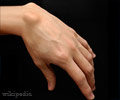The location of ligament tears within a baseball pitcher's elbow can be key to predicting the success of non-operative treatment for these injuries.

‘The location of ulnar collateral ligament (UCL) tears within a baseball pitcher's elbow can be key to deciding whether surgery should be recommended.’





"The goal of our research was to see if an objective measure like physical examination or imaging from an MRI could help predict non-operative treatment failures in these professional pitchers," commented Mark S. Schickendantz, the study's senior author from the Cleveland Clinic Sports Health Center in Cleveland, OH. "We determined that distal tears, involving where the ligament attaches to the bone across the joint, had higher rates of failure when not treated with surgery as compared to proximal tears." The study examined pitchers sustaining UCL injuries between 2006 and 2015 from one professional baseball organization, including both major and minor league teams. A total of 38 players with injury were identified, of which 32 (84%) received non-operative treatment for partial ligament tears. A proximal tear of the UCL was identified in 81% of the patients that were successfully treated non-operatively. By contrast, a distal tear of the UCL was detected in the patients that failed non-operative treatment and required surgical intervention.
"This data gives us a great starting point for using imaging to better prescribe a treatment protocol for professional pitchers," noted Schickendantz. "We can see that pitchers were 12.4 times more likely to fail non-operative treatment with a distal ligament tear, which is significant."
The study is the first to isolate variables that demonstrate successes and failures when it comes to treating professional pitchers with UCL injuries non-operatively.
Source-Eurekalert













